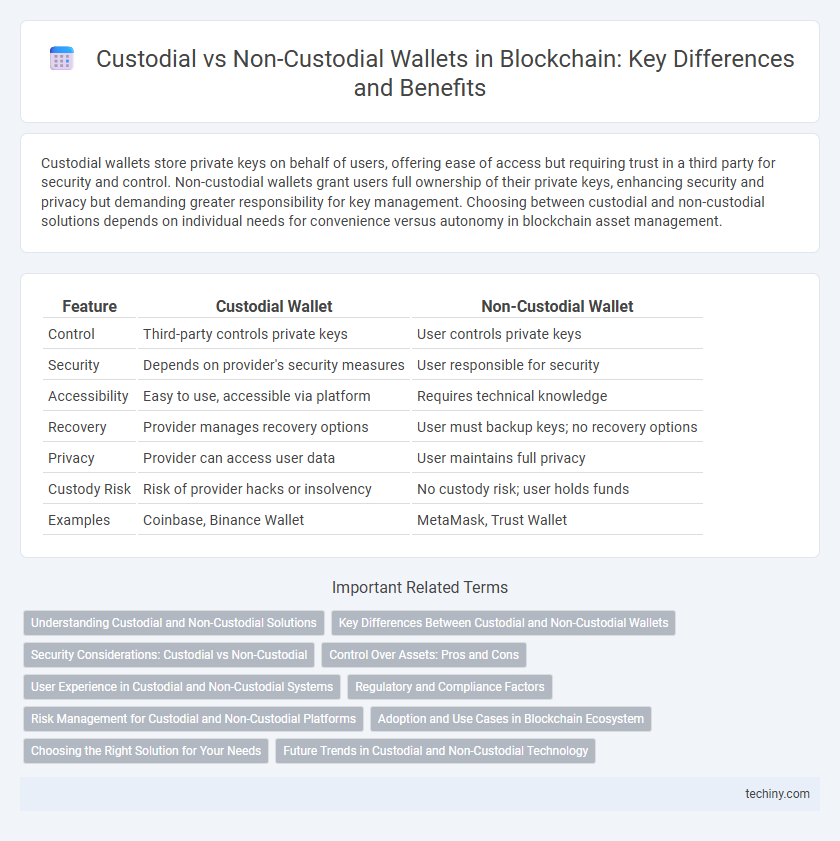Custodial wallets store private keys on behalf of users, offering ease of access but requiring trust in a third party for security and control. Non-custodial wallets grant users full ownership of their private keys, enhancing security and privacy but demanding greater responsibility for key management. Choosing between custodial and non-custodial solutions depends on individual needs for convenience versus autonomy in blockchain asset management.
Table of Comparison
| Feature | Custodial Wallet | Non-Custodial Wallet |
|---|---|---|
| Control | Third-party controls private keys | User controls private keys |
| Security | Depends on provider's security measures | User responsible for security |
| Accessibility | Easy to use, accessible via platform | Requires technical knowledge |
| Recovery | Provider manages recovery options | User must backup keys; no recovery options |
| Privacy | Provider can access user data | User maintains full privacy |
| Custody Risk | Risk of provider hacks or insolvency | No custody risk; user holds funds |
| Examples | Coinbase, Binance Wallet | MetaMask, Trust Wallet |
Understanding Custodial and Non-Custodial Solutions
Custodial blockchain solutions involve third parties managing private keys and overseeing asset security, offering ease of use but requiring trust in intermediaries. Non-custodial solutions enable users to retain full control over their private keys and digital assets, enhancing security and privacy while demanding greater user responsibility. Choosing between custodial and non-custodial models depends on factors like security preferences, user expertise, and the desired level of control over blockchain assets.
Key Differences Between Custodial and Non-Custodial Wallets
Custodial wallets store private keys on behalf of users, providing ease of use but requiring trust in a third party, while non-custodial wallets give users full control over their private keys, enhancing security and privacy. The key difference lies in asset ownership: custodial wallets limit direct access, potentially exposing users to platform risks, whereas non-custodial wallets place full responsibility on users for key management and transaction authority. Security protocols, user autonomy, and recovery options vary significantly between the two, influencing choice based on individual risk tolerance and technical proficiency.
Security Considerations: Custodial vs Non-Custodial
Custodial wallets store private keys on behalf of users, raising risks related to centralized breaches and regulatory compliance but offering ease of recovery. Non-custodial wallets grant users full control over private keys, enhancing security by eliminating single points of failure but requiring diligent personal key management to prevent loss. Security considerations favor non-custodial solutions for experienced users seeking autonomy, while custodial wallets may suit those prioritizing convenience despite potential vulnerabilities.
Control Over Assets: Pros and Cons
Custodial wallets offer convenience by entrusting a third party with asset management, which simplifies recovery but reduces direct control and increases exposure to counterparty risk. Non-custodial wallets provide full control over private keys, enhancing security and autonomy but requiring users to manage their own backup and recovery processes. The choice between custodial and non-custodial solutions hinges on balancing ease of use against the desire for complete ownership and control over blockchain assets.
User Experience in Custodial and Non-Custodial Systems
Custodial systems simplify user experience by managing private keys and security, enabling seamless access and recovery options, which benefits less tech-savvy users. Non-custodial systems enhance user control and privacy by requiring users to manage their own keys, offering greater autonomy but demanding higher responsibility and technical knowledge. The trade-off between convenience and control fundamentally shapes the user experience in blockchain asset management.
Regulatory and Compliance Factors
Custodial blockchain wallets are subject to stringent regulatory frameworks, including Know Your Customer (KYC) and Anti-Money Laundering (AML) compliance, enabling authorities to monitor and control asset custody. Non-custodial wallets provide users with full control over their private keys, minimizing regulatory oversight but raising challenges for compliance enforcement and potential legal liabilities. Regulatory bodies are increasingly focusing on bridging gaps by proposing clear guidelines for non-custodial wallet providers to enhance transparency while preserving user autonomy.
Risk Management for Custodial and Non-Custodial Platforms
Custodial platforms manage user assets by holding private keys, creating centralized points of failure vulnerable to hacks, regulatory actions, and internal mismanagement, thus requiring robust security protocols and insurance policies to mitigate risks. Non-custodial platforms empower users with sole control over their private keys, significantly reducing counterparty and regulatory risks but increasing the importance of individual key management and secure backup practices to prevent loss. Effective risk management in blockchain platforms balances the trade-offs between centralized control in custodial services and decentralized responsibility in non-custodial solutions.
Adoption and Use Cases in Blockchain Ecosystem
Custodial wallets dominate the blockchain ecosystem due to their ease of use and integration with popular exchanges, driving mass adoption among retail users and institutional investors seeking simplified asset management. Non-custodial wallets, favored for enhanced security and user control, enable decentralized finance (DeFi) applications, NFT ownership, and peer-to-peer transactions, promoting trustless interactions within blockchain networks. Adoption trends reveal custodial solutions facilitate onboarding, while non-custodial wallets empower advanced use cases demanding privacy and sovereignty over digital assets.
Choosing the Right Solution for Your Needs
Choosing between custodial and non-custodial blockchain wallets depends on security preferences and control over private keys. Custodial wallets offer ease of use and account recovery by entrusting third parties with assets, ideal for beginners or those valuing convenience. Non-custodial wallets provide full ownership and security of private keys, suiting users who prioritize privacy and direct control over their cryptocurrency holdings.
Future Trends in Custodial and Non-Custodial Technology
Custodial and non-custodial blockchain technologies are evolving with increasingly sophisticated security protocols and user-centric features, driven by advancements in decentralized finance (DeFi) and regulatory frameworks. Future trends emphasize seamless interoperability between custodial services and non-custodial wallets, enabling users to switch effortlessly while maintaining control over private keys and assets. Enhanced privacy solutions, multi-party computation (MPC), and hardware wallet integration will further redefine asset management, pushing the boundaries of secure and accessible blockchain infrastructure.
Custodial vs Non-custodial Infographic

 techiny.com
techiny.com